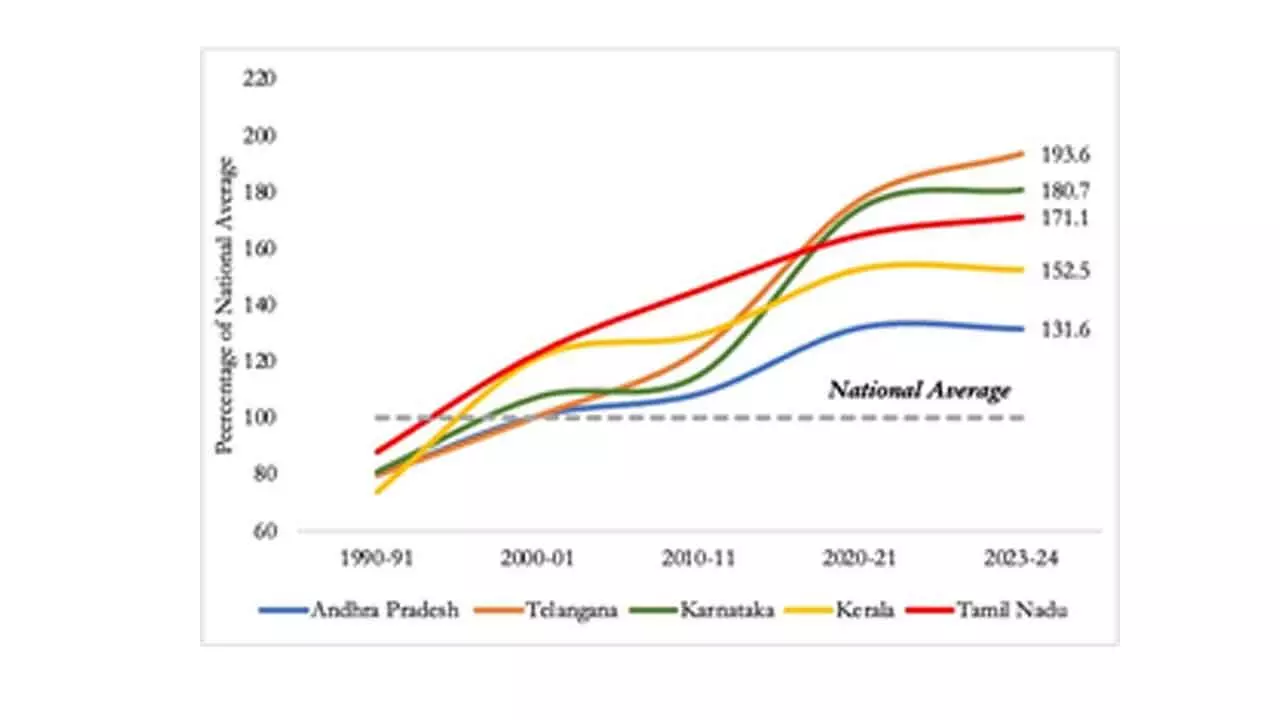Southern States Add 30% To India’s GDP
Telugu States together lead the pack, while Kerala losing share; Bihar, Odisha lagging; Maha, Guj, Delhi and Haryana post steady performance: EAC-PM paper
Southern States Add 30% To India’s GDP

Telangana’s avg per capita income is 94% higher than the national average, while that of Karnataka and Tamil Nadu is 81% and 71% higher, respectively. Gujarat’s per capita income is 160.7% of national average, while it’s 150% for Maharashtra
New Delhi: A notable development following the economic liberalisation in 1991 is the emergence of southern states, especially Karnataka and Telangana, as economic powerhouses and overall, the southern states together accounted for 30.6 per cent of India’s gross domestic product (GDP) in 2023-24, said a paper by the Economic Advisory Council (EAC) to the Prime Minister released on Tuesday.
The EAC-PM paper looked at the relative performance of states in terms of their share of the national economy and their per capita GDP as per cent of the national average since 1960-61.
It revealed that before 1991, southern states did not show expectational performance. However, since the economic liberalisation, the southern states have emerged as the leading performers.
Western and southern regions performed notably better than other parts of the country. Gujarat’s per capita income is 160.7 per cent of national average, while it's 150 per cent for Maharashtra. “In 2023-24, Karnataka, Andhra Pradesh, Telangana, Kerala, and Tamil Nadu together accounted for approximately 30 per cent of India’s GDP,” the paper noted.
Karnataka’s share in India’s GDP was 5.4 per cent in 1960-61, and it remained almost the same until 1990-91. However, after the policy shift, the State saw rapid growth, with its GDP share rising to 6.2 per cent by 2000-01 and reaching 8.2 per cent by 2023-24. This growth has positioned Karnataka with the third-largest share of India’s GDP.
Undivided Andhra Pradesh (Andhra Pradesh and Telangana) now accounts for 9.7 per cent, an increase of 2.1 percentage points since 1990-91 with most of the increase in share accounted for by Telangana. After bifurcation, the share of Andhra Pradesh has remained broadly flat.
Tamil Nadu also reversed its earlier pre-1991 decline by increasing its share from 7.1 per cent in 1990-91 to 8.9 per cent in 2023-24.
“Kerala’s share had increased from 3.4 per cent in 1960-61 to a peak of 4.1 per cent in 2000-01 but has since drifted down to 3.8 per cent in 2023-24. It is the only southern state that seems to be losing share,” the paper noted. Southern states also emerged as top performers in terms of per capita income as well since the 1990s. In 1990-91, all these southern states had per capita incomes below the national average, resulting in relative per capita incomes of less than 100. However, within the first decade following economic liberalisation, the relative per capita income of each of these states surpassed 100 and continued to rise rapidly thereafter.
As per the paper, the average person in Telangana now has an income level 94 per cent higher than the national average, while that of Karnataka and Tamil Nadu is 81 per cent and 71 per cent higher, respectively.
“Kerala’s per capita income has also increased to 152 per cent of the national average in 2023-24. We understand the numbers may be an underestimate for Kerala as it was a big receiver of remittances even in 1991,” the paper noted.
Authored by EAC-PM member Sanjeev Sanyal, the paper ‘Relative Economic Performance of Indian States: 1960-61 to 2023-24’ said the development of eastern part of the country remains a concern. It said maritime states have clearly outperformed other states, with the exception of West Bengal. Although Bihar’s relative position has stabilized in the last two decades, it remains significantly behind other states and requires much faster growth to catch up, the paper noted. Conversely, Odisha, traditionally a laggard, has shown a marked improvement in recent years.
Maharashtra, Gurajat, Delhi and Haryana have shown steady performance. Gujarat's per capita income is 160.7 per cent of national average, while it's 150 per cent for Maharashtra.
(West Bengal saw deepest decline under
Mamata’s rule: page 2)

